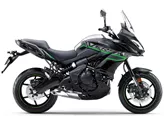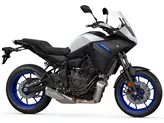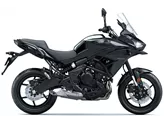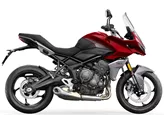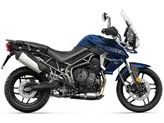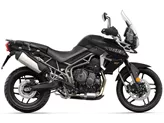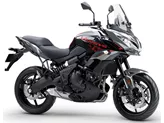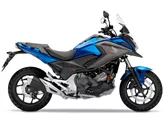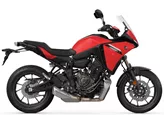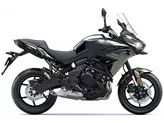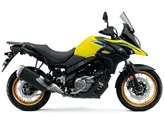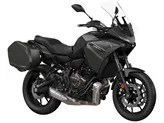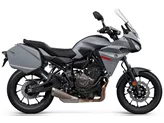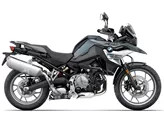Kawasaki Versys 650 2015 vs. Triumph Tiger 800 XRx 2015

Kawasaki Versys 650 2015

Triumph Tiger 800 XRx 2015
Overview - Kawasaki Versys 650 2015 vs Triumph Tiger 800 XRx 2015
The Kawasaki Versys 650 2015 and the Triumph Tiger 800 XRx 2015 are both enduro motorcycles that offer a combination of on-road and off-road capabilities. While they have similar features, there are some notable differences between the two models.
In terms of engine specifications, the Kawasaki Versys 650 2015 is equipped with a 649cc in-line twin engine that delivers 69 horsepower and 64 Nm of torque. On the other hand, the Triumph Tiger 800 XRx 2015 features a slightly larger 799cc in-line three-cylinder engine that produces 95 horsepower and 79 Nm of torque. This gives the Triumph Tiger 800 XRx a significant advantage in terms of power and performance.
Both motorcycles come with a chain transmission and upside-down telescopic fork front suspension, providing a smooth and responsive ride. The chassis of both bikes is made of steel, ensuring durability and stability.

Kawasaki Versys 650 2015
In terms of dimensions, the Triumph Tiger 800 XRx has a longer wheelbase of 1530mm compared to the Kawasaki Versys 650's 1415mm. This gives the Triumph Tiger 800 XRx better stability and handling, especially at higher speeds. The seat height of the Triumph Tiger 800 XRx is also slightly lower at 810mm compared to the Kawasaki Versys 650's 840mm, making it more accessible for riders with shorter inseams.
In terms of weight, both motorcycles have a kerb weight of 216kg with ABS. However, the Triumph Tiger 800 XRx has a slightly smaller fuel tank capacity of 19 liters compared to the Kawasaki Versys 650's 21 liters.

Triumph Tiger 800 XRx 2015
When it comes to strengths, the Kawasaki Versys 650 2015 offers a lively engine, comfortable seating position, effective adjustable windshield, comfortable chassis, and a sporty look. On the other hand, the Triumph Tiger 800 XRx 2015 boasts a complete equipment package, agile three-cylinder engine, comfortable seat, adjustable windshield, sporty chassis, good brakes, easy handling, and adjustable riding modes, ABS, and traction control.
In terms of weaknesses, the Kawasaki Versys 650 2015 lacks a gear indicator as standard, sways a little in fast bends, and requires a lot of hand force on the brakes. The Triumph Tiger 800 XRx 2015 has few weaknesses, with the main ones being that it is visually hardly distinguishable from its predecessor, and the footrests may drag early with a very sporty riding style.
In conclusion, both the Kawasaki Versys 650 2015 and the Triumph Tiger 800 XRx 2015 are capable enduro motorcycles with their own strengths and weaknesses. The Triumph Tiger 800 XRx offers more power and a slightly better handling, while the Kawasaki Versys 650 provides a comfortable riding position and a sporty look. Ultimately, the choice between the two will depend on the rider's preferences and priorities.
Technical Specifications Kawasaki Versys 650 2015 compared to Triumph Tiger 800 XRx 2015
Pros and Cons in comparison
Pros and Cons in comparison
Kawasaki Versys 650 2015

The new Versys 650 is truly more than just a revamped old lady - in addition to the contemporary look, the engine, chassis and equipment list have also been revised. It remains true to its sporty line, the 5 hp more benefit the mid-range for increased sovereignty - however, even the predecessor was a wonderfully lively fun machine. Instead, comfort is increased enormously by clever solutions such as the larger and now height-adjustable windshield. Finally, the optional features are also up to date: nice and roomy panniers, heated grips, LED fog lights, frame guard, gear indicator and a 12 V socket.
Triumph Tiger 800 XRx 2015

The Tiger 800 XRx is an absolutely faithful companion on all paths - and off-roads. The close relationship to its sister Tiger 800 XCx gives it a very robust and off-road capable chassis, the engine pulls up smoothly even from far below and therefore does not cause any stress even at walking pace. The XRx is designed more for road use only with the smaller 19 inch tyres at the front and 17 inch tyres at the rear. I didn't ride it as the only tester over the season, which means that several pilots used it in different ways and therefore also challenged it. That is basically quite a challenge, because the driving style of each individual rider is different. And that's where it showed again that the Triumph Tiger 800 XRx is an excellent all-rounder.
Price Comparison Avarage Market Price Kawasaki Versys 650 vs Triumph Tiger 800 XRx
There are a few key differences between a Kawasaki Versys 650 2015 and a Triumph Tiger 800 XRx 2015. In terms of price, the actual average price of a Triumph Tiger 800 XRx 2015 is about 38% higher. Compared to Triumph Tiger 800 XRx 2015 there are less Kawasaki Versys 650 2015 bikes available on the 1000PS.de Marketplace, specifically 4 compared to 12. It takes less time to sell a Triumph Tiger 800 XRx with 51 days compared to 85 days for the Kawasaki Versys 650. Since model year 2007 1000PS.de editors have written 39 reviews for the Kawasaki Versys 650 and 10 reviews for the Triumph Tiger 800 XRx since model year 2015. The first review for the Kawasaki Versys 650 was published on 25/07/2006 and now has more than 3,900 views. This compares to more than 18,500 views for the first review on Triumph Tiger 800 XRx published on 05/11/2014.


